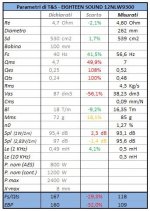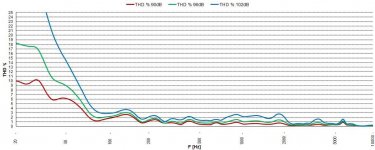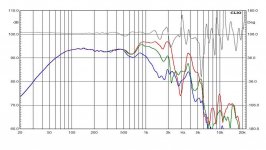"Frictional" losses play virtually no role in BSC, because the EM damping is orders of magnitude higher.
Tube amps have such high output impedances that they will completely change the crossover characteristics of a passive network. This will dramatically affect the SQ>
Tube amps have such high output impedances that they will completely change the crossover characteristics of a passive network. This will dramatically affect the SQ>
Virtually none of the classic instruments are capable of low notes.
Not many, although both the octobass and a 16' organ pipe produce a low C, which equates to 16 Hz.
I've never seen either of those instruments in Asia. They may exist but are exceedingly rare.
They don't, but that's not what I meant."Frictional" losses play virtually no role in BSC, because the EM damping is orders of magnitude higher.
This topic has been discussed before, relating thereto Dmtri has made some comments supported with research.
Last edited:
I was once interested in the woofer that is used in the Max 1. But I would definitely have used it in an active setup with LF boost.
The 12NLW9300 isn't a bad woofer, even though the measured parameters deviate from the specs and it's not particularly efficient.
The crossover frequency of the Max 1 is 2kHz, outside the pistonic range. The result is obvious: a messy/muffled midrange.
The crossover frequency of the Max 1 is 2kHz, outside the pistonic range. The result is obvious: a messy/muffled midrange.
Attachments
Last edited:
Yes, about one octave lower would have been better but still not perfect. But that would have called for another driver/horn combo and a crossover with higher complexity.
Regards
Charles
Regards
Charles
In such systems, BSC is often ignored, resulting in a lack of bass when placed in large rooms.
Add to this the (frictional) losses inherent to the electro-magnetic structures and suspensions of nearly all modern pro woofers and it becomes obvious why very few large format 2 way systems are tube-friendly, despite the (specified > not necessarily realistic) high sensitivity.
A few years ago, I mentioned the incapacity of the AN Ongaku to breath life into the cones of the JBL DD67000.
This also applies to the Unison Research Max 1 and 2 ao.
Beyond baffle step these higher efficiency woofer have either to much motor not enough mass or both so they are not good candidates for sub 40Hz if they can even make 40Hz. I wouldn't consider any speaker as "tube friendly" without looking at the impedance/phase plot. They can say what they want! The plot doesn't lie.
Rob 🙂
Last edited:
To me, this is outdated thinking. If one really wants the best in BSC, then they have to be considering multiple subs with independent DSP EQ. In this scenario, the stuff that you mention is not really relevant, true as it might have been back when people didn't use subs at all. They expected the mains to go all-the-way-down. I don't think like that anymore and I hope that people here don't either.
This is outdated thinking ,as well then, in regards to fs vs sub worthy.... xmax/power handling/sd matter much more.Beyond baffle step these higher efficiency woofer have either to much motor not enough mass or both so they are not good candidates for sub 40Hz if they can even make 40Hz
I’m with Earl, 2 way mains stacked on subs, w/dsp for 4 yrs now…….wouldn’t do it any other way.😎
Kind of seem like strong words.. for something which isn't always a problem, and in any case can be fixed.Tube amps have such high output impedances that they will completely change the crossover characteristics of a passive network. This will dramatically affect the SQ>
^ Of course it can be fixed, but who does that?
And sorry, I don't see the words as anything but true. I've measured these things, many times.
And sorry, I don't see the words as anything but true. I've measured these things, many times.
Earl, when designing for use with a tube amplifier, isn’t it a simple matter of designing the crossover (in a sim) with a series resistance that is the equivalent of the output impedance of the transformer secondary?
^ Again, of coarse it is, I've done it many times. That's not the point. Many people will just hook up their speakers to tube amps and listen to the differences and equate that to the amps. Not so. Not all tube amps have the same output resistance.
One can also use a conjugate network that make the crossover impedance independent, but that just adds cost and draws more power for the same SPL.
One can also use a conjugate network that make the crossover impedance independent, but that just adds cost and draws more power for the same SPL.
Thanks Earl. That wasn’t meant as a challenge; just to make sure my understanding was sufficient enough to follow the points you are making.
Of course it can be fixed, but who does that?
The man who recently installed this custom 2-way system:
- Green: Impedance without linearization,
- Orange: Impedance with cross over impedance linearization but without Low frequency-impedance linearization
- Blue: low frequency impedance linearization put on Low
- Purple: low frequency impedance linearization put on Medium
- Yellow: low frequency impedance linearization put on High.
Last edited:
Seriously?? No you can add 20b all you want. You should be using drivers that don't require band aids for poor design choices.This is outdated thinking ,as well then, in regards to fs vs sub worthy.... xmax/power handling/sd matter much more.
Rob 🙂
No harm no foul
You use the drivers that best suit the job. If you want a high motor strength, low Q/le subwoofer with a lightish cone (I do) then you are going to have a rising frequency response ... taming it with eq is easy. Extending the LF response with EQ...easy as well...
My sub drivers are as sensitivity through the sub range as an Ultimax 18....🤷♂️
You use the drivers that best suit the job. If you want a high motor strength, low Q/le subwoofer with a lightish cone (I do) then you are going to have a rising frequency response ... taming it with eq is easy. Extending the LF response with EQ...easy as well...
My sub drivers are as sensitivity through the sub range as an Ultimax 18....🤷♂️
Last edited:
Rob is right.
While some shelving and a few dBs of boost here and there won't hurt (much), it's better to use appropriate drivers than resorting to excessive EQ.
This is exactly the problem with the JBL M2, too many 'corrections' for my taste.
Camplo, it's (also) true that sensitivity provides leeway. I'd even argue that efficiency (= less loss) trumps pretty much everything else.
There's plenty of output left after BSC around 200 Hz:

While some shelving and a few dBs of boost here and there won't hurt (much), it's better to use appropriate drivers than resorting to excessive EQ.
This is exactly the problem with the JBL M2, too many 'corrections' for my taste.
Camplo, it's (also) true that sensitivity provides leeway. I'd even argue that efficiency (= less loss) trumps pretty much everything else.
There's plenty of output left after BSC around 200 Hz:
Last edited:
- Home
- Loudspeakers
- Multi-Way
- Is it possible to cover the whole spectrum, high SPL, low distortion with a 2-way?


